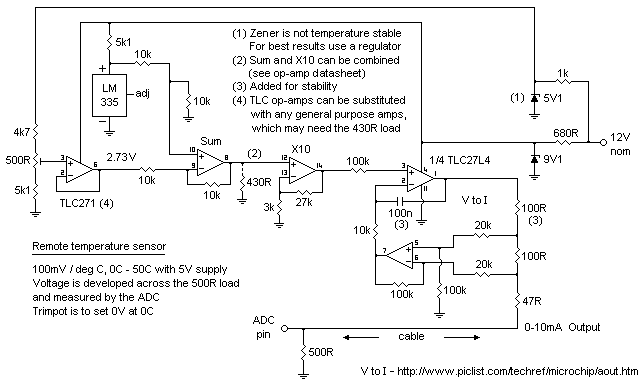
This is an application of the voltage-to-current converter circuit for use with remote sensing. The LM335 has a small (10mV) output change per degree Kelvin and its common use with long wires makes it susceptible to interference by noise
Three issue are dealt with in this circuit -
1) increasing the mv per degree
2) conversion to Centigrade
3) increasing its immunity to noise

An amplifier with a gain of 10 (x10) changes the output from 10mV to 100mV per degree, giving a range of 0 - 50C (0mV - 5000mV)
Because the LM335 is Kelvin-based (-273 degC), it has an output of 2.73V at 0 degC. To negate or offset this, -2.73V is added to the LM335 signal with a summing buffer. This is followed by the x10. So now 2.73V from the LM335 at 0 degC is 0mV from pin14 of the op-amp, 2.83V at the LM335 is now 100mV = 1 degC and so on
Changing the offset to, eg 2.63V, and keeping x10 amplification will allow measurement from -10 degC to 40 degC. Changing the gain of the following stage alters the range. Amplifiier gain is a standard calculation ; (R1+R2) / R2, eg (27k+3k) / 3k = a gain of 10, or (24k+6k) / 6k = a gain of 5, giving 50mV per degC, which is a range of 100 degrees
By setting the offset and gain, both the lower limit and range can be adjusted within the LM335's specs
The immunity to noise is addressed by converting the output voltage to a current. This allows a very much longer cable run to be used for remote sensing without degradation of the signal. At the PIC end of the cable, a load resistor converts this current back to a voltage that the ADC can measure. In this particular circuit, 0mA represents 0C and 10mA represents 50C
Using a load resistor of 500 ohms, 10mA across it develops 5000mV, by way of V = IR, or V = 0.01 x 500 = 5V. Similarly, 25C would be represented by 5mA on the cable -> 2500mV at the PIC pin
If required, the maths can be simplified by using a Vdd of 5120mV because the ADC range is 1024 steps, not 1000. This means that the ADC LSb value is 5120/1024 = 5mV, not 4.883mV (5000/1024)
For example ; A temperature of 24C = 2400mV, converted to 4.8mA, converted back to 2400mV by the 500 ohm load, Vdd = 5120mV
The ADC result is 2400/5 = d480 (Vdd = 5000mV, result = d491.52)
For 23C the result is 2300/5 = d460 (Vdd = 5000mV, result = d471.04)
Note that the full-scale result for a 500 ohm resistor is less than Vdd if Vdd is 5.120V, because the highest voltage that can be developed across the load resistor is 5000mV. If a load resistor of 512 ohms was used then full-scale = Vdd = 0.01 x 512 = 5.120V. However, that does re-introduce decimal places back into the results
The load resistor can be scaled to suit Vdd. eg at 3V (or 3.072V) the load resistor will be 3/5 of 500, or 300 ohms. 10mA across this will develop 0.01 x 300 = 3V
| file: /Techref/io/sensor/0-10mA_remote_lm335.htm, 3KB, , updated: 2012/8/7 13:35, local time: 2025/8/29 11:42,
216.73.216.36,10-3-192-107:LOG IN
|
| ©2025 These pages are served without commercial sponsorship. (No popup ads, etc...).Bandwidth abuse increases hosting cost forcing sponsorship or shutdown. This server aggressively defends against automated copying for any reason including offline viewing, duplication, etc... Please respect this requirement and DO NOT RIP THIS SITE. Questions? <A HREF="http://techref.massmind.org/Techref/io/sensor/0-10mA_remote_lm335.htm"> Remote analog sensor electronics LM335A Temperature</A> |
| Did you find what you needed? |
Welcome to massmind.org! |
|
Ashley Roll has put together a really nice little unit here. Leave off the MAX232 and keep these handy for the few times you need true RS232! |
.